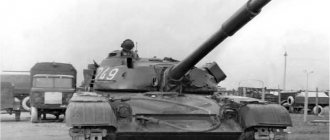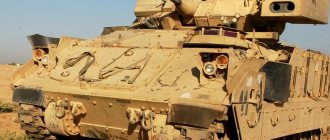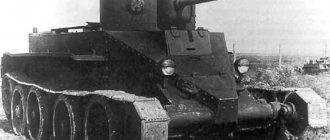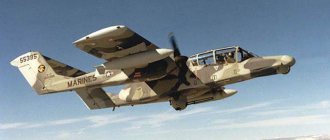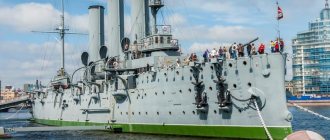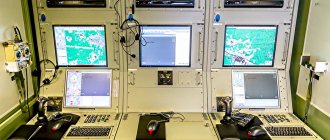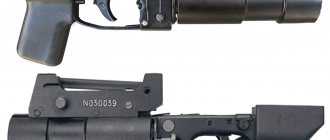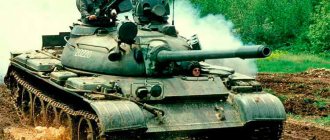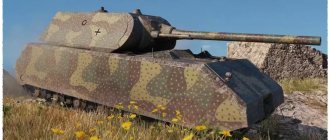In the 20s of the last century, the USSR began to develop completely new tanks with increased maneuverability. A few years later, information began to arrive that Vikkers A6 tanks were being built in the UK, weighing 16 tons, and in those days this was quite a significant weight.
At the same time, a project for a similar Grosstraktor machine appeared in Germany. After analyzing the technical parameters of foreign heavy combat vehicles, a decision was made to create a domestic analogue, which later became the T-28 medium tank.
History of creation
In 1930, a purchasing commission visited Great Britain and was shown the then new A-6 tank. But the Vikkers company refused to sell the sample, offering in return services for the construction of a new machine, which was to be created in the USSR. At the same time, significant sums of money were requested, and the purchase of light vehicles was imposed. For this reason, the Mechanization Directorate of the Red Army initiated the creation of a tank project, which was entrusted to the F. Dzerzhinsky Academy and a special design bureau at the VOAO.
Projects were presented already in the summer of 1931, and the academy’s vehicle was based on elements of the chassis from the T-26 tank, and the VOAO equipment was built in the likeness of the Vickers A-6. This project, created by S. Ginzburg, O. Ivanov, V. Zaslavsky and A. Gakkel, was originally designated T-28.
In the summer of 1932, a prototype of the T-28 tank was shown to representatives of the Red Army, who approved the vehicle.
One of the comments was the requirement to use a diesel engine, as well as an improved 76 mm PS-3 gun. The project was modified to meet new requests, but the tank did not receive a new engine design, since the product did not leave the experimental stage. The command of the armored units of the Red Army did not even wait for the construction of a new vehicle, but immediately issued an order for serial production.
Attachments
The hydraulic system and PTO make the T-28 tractor a universal machine. With a wide range of attachments, the tractor can make the work of farmers on large and small farms easier.
The following attachments may be used in combination with a tractor:
- equipment for planting potatoes;
- root diggers;
- milling equipment;
- harrow;
- mowers of various types;
- seeders;
- carts and trailers;
- multi-furrow plows;
- irrigators;
- sprinklers;
- fertilizer sprinklers;
- hay tedders;
- pitchfork;
- cargo platform (maximum cargo weight for a cargo dump platform is 2000 kg).
The photo shows a T-28 plowing a vegetable garden - a homemade plow is used for plowing
Serial production and prototypes
The T-28 was chosen for assembly because the company had qualified personnel and the necessary machine tools. Documentation for the new car arrived at the plant in December 1932. Despite problems with tooling and equipment, the first 12 vehicles were assembled by May 1, 1933.
Further expansion of production was difficult; numerous technical and technological problems arose. At the same time, the plant worked together with other enterprises that supplied components for assembly. In total, until 1940, “Krasny Putilovets” assembled from 503 to 523 vehicles (the exact figure is unknown).
The produced vehicles are divided into several series, which are distinguished by their weapons and appearance elements. There are models of 1933, 1934, 1938 and 1940. The most distinct is the last option, which received a conical main turret, but only 13 of these vehicles were built. After installing screens on the armor, the designation of the vehicles changed to T-28E.
In 1936, T-28A tanks were produced, characterized by a reduced gear ratio of the transmission gear pairs.
The vehicles had an increased speed, but later the idea was abandoned.
In addition, there were a number of experimental vehicles based on the T-28 chassis:
- wheeled-tracked T-29;
- engineering vehicle IT-28, transporting a bridge truss with a lifting capacity of 50 tons;
- anti-aircraft tank SU-8;
- self-propelled guns with a 152 mm mortar and a coastal gun;
- self-propelled howitzer SU-14, equipped with a 203 mm B-4 gun.
Design of the T-28 tank
The body of the T-28 vehicle was assembled from armor sheets made using rolling technology. To strengthen the structure, triangular gussets were used, which added torsional rigidity to the body and resistance to shell hits. All early vehicles produced until the end of 1936 had hulls assembled with rivets from homogeneous armor sheets.
Later, steel with surface carburization began to be used, and the hull assembly technology became combined - riveted and welded. In 1936-38. Both designs were used. After 1938, only riveted-welded products were produced.
In the front part there was a driver's workplace, which was protected by a folding screen with a viewing slot and triplex glass. The driver entered his seat through a hatch in the roof of the superstructure. The use of a front hatch provided improved visibility for the mechanic, but the element jammed from hits from shrapnel and large-caliber bullets.
During the Winter War, several T-28 tanks were equipped with a modernized hatch with an installed armor plate 20 mm thick.
The armor protection of a standard tank consisted of sheets of the following thickness:
- front hull sheets – 15-30 mm;
- side part – 20 mm;
- aft section – 20 mm;
- frontal and side parts of the turret – 20 mm;
- horizontal elements of the body – 10-18 mm.
Later, protection was strengthened by installing armor screens 20-30 mm thick by welding. The event significantly increased the resistance of the T-28 hull to artillery fire, but the mass of the shielded vehicle increased to 32 tons.
In the rear part there was a power plant, which included an M-17 12-cylinder aviation engine adapted for ground work, which developed a power of 450 hp. The fuel supply was located in 2 containers located on the sides of the body in the transmission compartment. The total capacity was 660 liters; B-70 gasoline was used as fuel. The aviation past affected the ignition system, which consisted of 2 magnetos.
The torque from the engine was transmitted to a 5-speed manual transmission using a dry clutch. The design of the transmission includes a fuse that prevents the gear from being engaged without interrupting the power flow. On the sides of the tank there are final drives with multi-disc clutches, as well as band brakes.
The chassis includes 12 paired road wheels mounted on spring-loaded balancers. The drive wheel is located at the rear, the tension of the track is produced by the displacement of the idler.
The early T-28s were equipped with a 76 mm KT-28 cannon, built on the basis of the barrel of a regimental gun.
Recoiling and rolling devices were modified, the design of which corresponded to the specifics of the tank gun. The gun was mounted in a mantlet and equipped with periscope and telescopic sights. Later, in the spring of 1938, the L-10 gun with a similar caliber and an increased barrel length began to be used.
On the right side of the gun there was a ball intended for the DT machine gun. There was a similar device in the turret niche (not on all produced T-28s). 1 machine gun with a firing sector of 165⁰ was located in small towers.
On board the T-28 there were 69 cannon cartridges containing high-explosive fragmentation and shrapnel grenades. There were no armor-piercing shells in the early guns; they appeared only with the advent of the L-10. The use of such ammunition, which pierced a 50 mm thick plate from a distance of 1000 m (at an angle of 30⁰ to the vertical), significantly increased the combat value of the T-28. The machine guns were supposed to carry 126 magazines with a total capacity of 7938 rounds.
The T-28's armament was housed in 3 turrets. The main tower of a welded or combined structure is located along the axis of the machine. In the aft niche there is a slot for a machine gun mounting yoke, which was later replaced by a ball system. For access inside, hatches located on the roof are used. The configuration of the parts changed during the production of the tank. On vehicles produced after 1936, a turret mount for an anti-aircraft machine gun was used.
The roof panel had a stamping in the form of a 5-pointed star, which made it easier to identify the car from the air. There are hatches on the side walls for firing from personal weapons. The turret pole rotated together with the hull. Between the seats and on the racks there were racks for storing cartridges for the gun. Inside was the tank commander, gunner and loader, who was also the operator of the on-board radio station.
The small machine gun turrets were identical in configuration except for the side panels, which had viewing slits.
The towers are single-seater, equipped with folding hatches. The weakness of the tower's protection led to the installation of a ball amplifier, and then the installation of armor screens. On the side of the T-28 tanks there were boxes for smoke exhaust devices. The configuration and design of the components depends on the year the machine was built.
Owner reviews
Stepan, Tomsk:
I got the tractor along with the plot from my grandfather. In its non-working form, the car sat in a garage for about six years; no one needed this tractor; relatives wanted to scrap it. Repairs had to be done, of course. I overhauled the piston group, repaired the cabin myself, strengthened and welded it, and replaced rusted areas. As a result, I got a car with excellent engine traction and average fuel consumption. I don’t have any attachments for it, I’m only renting a trailer, I want to make or buy a plow (for now I need to calculate which will cost less). The tractor is good! I recommend
Technical characteristics of the T-28 medium tank
Combat weight, t: 25.4;
Crew, people: 6;
Number of issued, pcs: 503.
Dimensions:
- Case length, mm: 7370;
- Width, mm: 2870;
- Height, mm: 2625;
- Ground clearance, mm: 500.
Reservations:
- Armor type: rolled homogeneous steel;
- Body forehead (top), mm: 30;
- Body forehead (middle), mm: 15;
- Body forehead (bottom), mm: 30;
- Hull side, mm: 20+10 (screen);
- Hull stern, mm: 18-20;
- Bottom, mm: 15-18;
- Tower forehead, mm: 20;
- Gun mantlet, mm: 20.
Weapons:
- Guns: 76.2 mm KT-28 mod. 1927/32 / 76.2 mm L-10 (since 1939);
- Gun ammunition: 69;
- Machine guns: 4-5 × 7.62 mm DT;
- Ammunition: 1200 rounds.
Mobility:
- Engine: V-shaped 12-cylinder carburetor liquid cooling M-17T;
- Engine power, l. s: 450;
- Highway speed, km/h: 42;
- Speed over rough terrain, km/h: 20-25;
- Cruising range on the highway, km: 180-190;
- Cruising range over rough terrain, km: 120-140;
- Climbability, degrees: 37;
- Climbable wall, m: 1.0;
- Ditch to be overcome, m: 3.5;
- Fordability, m: 1.0.
Modifications of the tank and vehicles based on it
- T-28 - prototype (1932). Armament: 45 mm tank gun mod. 1932 (installed 37 mm due to lack of availability) and three DT machine guns.
- T-28 - the first production model (1933-1934). Armament: 76.2 mm KT-28 tank gun and 4 DT machine guns.
- T-28 - the main production model (1934-1938). Armament: 76.2 mm tank gun and 5 DT machine guns.
- T-28 - the main production model (1938-1940). Armament: 76.2 mm L-10 tank gun and 5 DT machine guns.
- T-28 - with a conical turret (1940). Armament: 76.2 mm KT-28 tank gun and 4 DT machine guns. 13 cars were produced.
- T-28 E - shielded tank (1939-1940). The armor protection of the frontal part of the hull and turrets has been strengthened due to the installation of additional armor plates.
- T-28 - with hydromechanical transmission (1937-1938). An experimental hydromechanical transmission was installed on the production tank. A prototype has been released.
- T-28 - with torsion bar suspension (1938). The production tank was equipped with a torsion bar suspension with road wheels from SMK. A prototype has been manufactured.
- T-28 - minesweeper tank (1939). A serial tank equipped with a rutted roller trawl.
- IT-28 - bridge tank (1940). Armament: two DT machine guns. A small batch of cars was produced.
- Electric minesweeper - based on the T-28 (1940). Carried out remote detonation of mines using electromagnetic radiation from an ultra-high-frequency generator installed in the tank. A pilot generator installation has been manufactured.
- 152.4 mm self-propelled mortar - based on the chassis of the T-28 tank (1932). Experimental self-propelled unit. Armament: 152.4 mm mortar mod. 1931 and two DT machine guns.
- 152.4 mm self-propelled coastal gun - based on the chassis of the T-28 tank (1933). Experimental self-propelled unit. Armament: 152.4 mm B-10 naval gun.
- T-29-4, T-29-5, T-29 - experimental wheeled-tracked tanks (1934). Created based on the use of components and assemblies of the T-28 tank according to a similar layout scheme. Armament: 76.2 mm KT-28 tank gun (PS-3 or L-10) and 4 DT machine guns. Several prototypes were produced.
- SU-8 is an experimental self-propelled unit based on the chassis of the T-28 tank (1935). Armament: 76.2 mm anti-aircraft gun mod. 1931 and a machine gun.
- SU-14, SU-14-1 - self-propelled artillery units (1935, 1936). Created based on the use of components and assemblies of T-28 and T-35 tanks. Armament: 203-mm howitzer B-4 mod. 1931 or 152.4 mm B-10 naval gun.
- MBV - motor armored car (1936-1937). Created based on the use of components, assemblies and gun turrets of the T-28 and T-35 tank. Armament: three 76.2 mm KT-28 tank guns (or L-11, which were replaced by F-34 during the war), 8 DT machine guns and 4 Maxim machine guns. 2 samples released.
- SU-14Br2, SU-14-2 - self-propelled artillery units with an armored fighting compartment (1939). Created on the basis of the SU-14 and SU-14-1. Armament: 152.4 mm cannon mod. 1935 2 vehicles reserved.
Device
Cabin
As mentioned above, the initial configuration of this model tractor did not include a driver’s cab. All the main control components of the car were placed in the space in front of the driver's seat. After structural modifications, the agricultural unit still received an all-metal cabin, which, although not distinguished by the presence of amenities for the driver, met all requirements and safety standards. The cabin was designed for one operator; its individual parts were fastened together with rigid metal bridges, which suggests strength. The lack of comfort is pronounced by the standards of our time - for the years of active production of the car, everything looked quite good. Adjustable seat, front panel with panels displaying information about all functional states of the unit. In addition to the instrument panel, the cockpit contained a steering column, as well as gearshift levers.
Control
As mentioned earlier, control was carried out using a steering mechanism, which consisted of a steering column and a cardan transmission. From his seat, the operator activated the gearshift levers and could also use the driver’s standard set of brakes and clutch. The operation of all important components and mechanisms is controlled by the operator using the dashboard. One of the main functional advantages that allows the tractor not to slip even on moist soil is the presence of a mechanism for changing the angle of rotation of the guide wheel axle.
Attachments
“Vladimirets” was equipped with a hydraulic system that allows it to work with mounted, semi-mounted and trailed equipment. In addition, the tractor had a power take-off shaft - a mechanism that allows the rotational force of the engine to be transmitted to attachments. Nowadays, such a set is supplied with every tractor, but in the last century such technical characteristics made an indelible impression. On top of that, the Vladimir Tractor Plant was concerned with creating a large number of attachments that could satisfy any agricultural needs. Among the options available for use were:
- Tooth harrow.
- Disc harrow.
- Rake.
- Oval shovel.
- Plow.
- Milling cutter.
- Trailer.
- Peeler.
Figure 5. “Vladimirets” with attachments.
Combat use of T-28 tanks
The T-28 made its debut in the Polish campaign, but the lack of serious opposition did not allow it to somehow prove itself. In Finland, the “twenty-eighths” operated as part of the 20th Tank Brigade and proved themselves to be quite good: in particular, unlike other vehicles, they could confidently move through deep snow and had a very solid “light” in order to successfully “gnaw through” line fortifications Mannerheim.
On the other hand, the 37-mm anti-tank tanks in service with the Finns clearly demonstrated that their armor was clearly insufficient to withstand the fire of even these firecrackers. However, the good maintainability of the “twenty-eighth” was noted - more than 80% of the damaged “boxes” were returned to service!
At the beginning of the Second World War, later modifications of the T-28 were still effective, posing a serious threat to the Panzerwaffe, but the general nature of the first weeks of the war, the wear and tear of these not very new vehicles and the shortage of spare parts for them caused the loss of most of the tanks in border battles.
Subsequently, they flashed sporadically on certain sections of the front, defending Moscow, as well as Leningrad, where individual “boxes” remained on the move until the 44th, which was due to the availability of the required number of spare parts at the Kirov plant that manufactured them.

